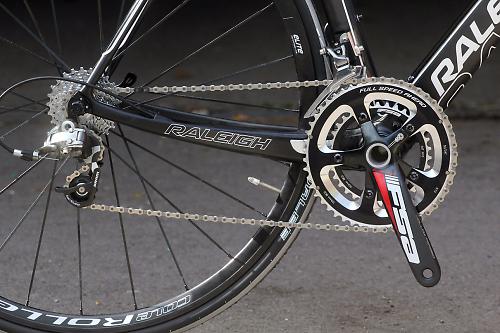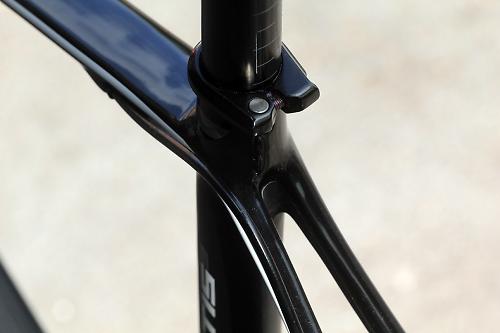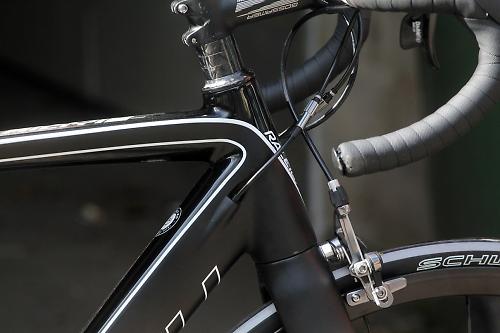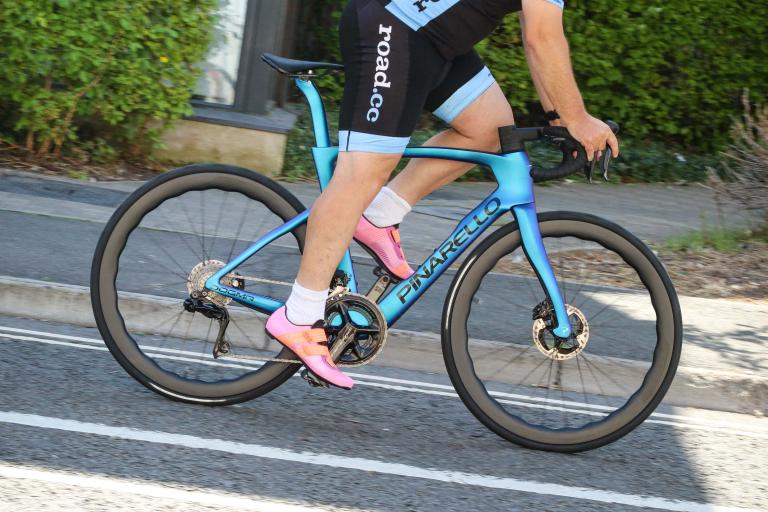- News
- Reviews
- Bikes
- Accessories
- Accessories - misc
- Computer mounts
- Bags
- Bar ends
- Bike bags & cases
- Bottle cages
- Bottles
- Cameras
- Car racks
- Child seats
- Computers
- Glasses
- GPS units
- Helmets
- Lights - front
- Lights - rear
- Lights - sets
- Locks
- Mirrors
- Mudguards
- Racks
- Pumps & CO2 inflators
- Puncture kits
- Reflectives
- Smart watches
- Stands and racks
- Trailers
- Clothing
- Components
- Bar tape & grips
- Bottom brackets
- Brake & gear cables
- Brake & STI levers
- Brake pads & spares
- Brakes
- Cassettes & freewheels
- Chains
- Chainsets & chainrings
- Derailleurs - front
- Derailleurs - rear
- Forks
- Gear levers & shifters
- Groupsets
- Handlebars & extensions
- Headsets
- Hubs
- Inner tubes
- Pedals
- Quick releases & skewers
- Saddles
- Seatposts
- Stems
- Wheels
- Tyres
- Health, fitness and nutrition
- Tools and workshop
- Miscellaneous
- Cross country mountain bikes
- Tubeless valves
- Buyers Guides
- Features
- Forum
- Recommends
- Podcast
review
£2,500.00
VERDICT:
One of the best-handling frames on the market which should build Raleigh's performance reputation
Weight:
7,340g
Contact:
www.raleigh.co.uk
At road.cc every product is thoroughly tested for as long as it takes to get a proper insight into how well it works. Our reviewers are experienced cyclists that we trust to be objective. While we strive to ensure that opinions expressed are backed up by facts, reviews are by their nature an informed opinion, not a definitive verdict. We don't intentionally try to break anything (except locks) but we do try to look for weak points in any design. The overall score is not just an average of the other scores: it reflects both a product's function and value – with value determined by how a product compares with items of similar spec, quality, and price.
What the road.cc scores meanGood scores are more common than bad, because fortunately good products are more common than bad.
- Exceptional
- Excellent
- Very Good
- Good
- Quite good
- Average
- Not so good
- Poor
- Bad
- Appalling
With a sweet-handling, pro-quality frame, decent components and great wheels, the Raleigh Militis 3 should put Raleigh back on the high-performance map.
“Yeah, but it’s two and a half grand for a Raleigh!”
The comment came from a fellow bike fan after five minutes of me singing the praises of Raleigh’s flagship frame. The Militis had just got me through the first day of the Tour of Wessex in a smidge over six hours for the 107 mile route which takes in the likes of Cheddar Gorge and Dorset’s evil 25 percent King Alfred’s Tower climb and to say I was feeling surprisingly fresh was an understatement.

Don’t get me wrong, I’d done a decent amount of training but the Militis had performed amazingly well so with a bit of luck the type of comment above should soon disappear.
If you’d been watching the Tour Series on TV over the last month or so you’d have seen plenty of the Militis under Tom Scully of as he took the gold jersey. Team Raleigh were riding the fully fledged Militis Team sporting SRAM Red and carbon COLE rims but the only option available to the public at the moment is this here Militis 3. It’s the same frame and fork package but with slightly cheaper kit.
Frame: designed by Raleigh for stiffness and light weight
Raleigh have designed the frame and fork themselves creating their own moulds for manufacture. An expensive way of doing things rather than just buying sections or whole frames from a catalogue in Taiwan but a better result for both the designer and the customer. Adding to that initial outlay is the fact Raleigh use tubes designed specifically for each frame size allowing for better tweaking of the overall ride quality.

Varying carbon fibre grades are used throughout the frame with the one Raleigh happiest to shout about is Toray’s T800. Stiff with a high tensile strength, it’s perfect for high load areas like the down tube and bottom bracket area.
The design follows a tried and tested method, oversize the head and down tubes, bottom bracket area and chain stays for power while the ridiculously narrow seat stays tames the frame’s harshness before it reaches the rider. It’s then up to the seat and sloping top tube to bring everything together.
That down tube is a behemoth as well, a kind of rounded triangle profile that’ll you struggle to get your hand around. It’s moulded as one piece with the head tube just to eke out every last little bit of stiffness. You can see for yourselves from the photos just how much material is around the bottom bracket area to accommodate the larger diameter press fit BB30 bearing cups.

Views were mixed about the looks but personally I loved it. The mix of matt black paint with lacquered nude carbon looked great in the sunshine plus internal cabling keeps everything smooth and flowing.
The fork is full carbon, tapered steerer, dropouts the lot. The crown is 1.5-inch tapering to 1 1/8-inch at the stem end and the legs have a minimal curve with their profile narrowing towards the dropout.
The whole frameset might look pretty chunky but a quoted weight of 880g for the frame and 395g for the fork is impressive. It comes with full UCI approval as well, if that’s what you need.
Components: SRAM Force teams up with FSA and Cole
The rest of the build is some pretty decent kit considering the amount of money that’s gone into the frame. SRAM’s second tier Force takes care of the shifting and braking with a small deviation to a FSA Energy BB30 chainset. Raleigh’s own website states that it’s a 53/39 but our test bike came with a compact 50/34.

FSA also provide the bars, stem and seatpost all from their Gossamer range. Nothing flash but it does the job and looks pretty good.
The Cole Rollen Elite wheels use 27mm deep rims that are fully anodised, so they look like carbon wheels at a quick glance. Weight is 1570g which is pretty good for a £300 wheelset and the use of Cole’s own sealed bearings should see them keep out the worst of the weather. The front uses 20 spokes while the rear 24, aero bladed on both for that little bit of extra wind cheating.
The ride: balaced and quick downhill
Once out on the road the Militis feels like a lot of other massively overbuilt carbon bikes, quick but no real passion or feedback. A tool for the job shall we say. Once you adapt to that though and download the numbers post ride you realise what an effective tool it is.
Stiffness is obviously the overriding factor and the Militis will certainly lay the power down without even the slightest whiff of flex. Pair that stiffness with an all up weight of 16.18lb (7.34kg) and the Raleigh accelerates and climbs up there with the best of them.

The ace up its sleeve though is descending. This thing is so balanced you can really push it through the bends at high speed. You can brake later and deeper into a bend and the Raleigh chases direction instantly with just a small shift in body weight. The 73° head angle gives quick steering coupled with the supplied narrow bars but it never feels skittish. There is a small amount of give in the fork legs which just tames things a little to keep control on rough roads. Maxed out at 55mph the Militis still felt as composed as when it was doing 20mph.
The stiffness doesn’t mean an uncomfortable ride though. It’s not plush but at least you’re not getting shaken to bits. As I mentioned in the opening paragraph, at the end of a hard six hour ride I got off of the Raleigh feeling pretty fresh.

The fork does do a good job at the front end taking out the minor vibration while the seat stays does the same at the rear. The Selle San Marco Concor saddle is pretty minimal so you need as much absorption as possible. The shallow drop Gossamer bars have a flattened profile on the top which also adds to comfort.
SRAM’s Force has a feel to it that matches the Militis perfectly, efficiency that comes at a cost of feel and feedback. The shifting through the Double-Tap levers is precise with just a small click noting your change, as long as you get it spot on. Just a degree or two out on your swing arc and it soon gets flustered and due to the lack of feedback you don’t really know where it’s at.
The compact chainset is paired up with an 11-26 10-speed cassette giving you a decent spread of gears for varying terrain.

One component that does get a special mention is the COLE wheels. They roll very well and thanks to the low weight the spin up and climb easily. The anodised finish lasted better than I expected. It was starting to wear after a couple of wet rides but didn’t look too bad. It doesn’t affect the great braking performance of the Force callipers either which was my initial concern.
The Militis 3 is a well specced, beautiful handling machine which should definitely put Raleigh back on the map. At the time of riding I likened the Raleigh to the hugely expensive Fondriest TF Zero. Not quite as refined but very similar characteristics and qualities which considering it costs a third of the price is pretty impressive. The build kit is a decent mix of functionality and performance but the majority of your investment has gone into the frame and fork making it ripe for upgrades.
Overall, the Militis 3 is a thoroughbred race machine with performance and handling to match. It’ll happily do the long miles at a more sedate pace but the real rewards come when it’s being ridden hard. It may be “Two and a half grand for a Raleigh!” but it’s money well spent.
Verdict
One of the best-handling frames on the market which should build Raleigh's performance reputation.
road.cc test report
Make and model: Raleigh Militis 3 (2013)
Size tested: 55cm
About the bike
State the frame and fork material and method of construction. List the components used to build up the bike.
Gearset: SRAM Force 10 speed shifting lever, front and rear derailleur, FSA Energy 53/39t chainset, crank lengths 50/53cm – 170mm, 55/57cm – 172.5mm, 59cm - 175mm, SRAM 1030 11-26t w/ SRAM chain
Brakeset: SRAM Force
Wheelset: Cole Rollen Elite wheels, Schwalbe Durano S 700 x 23c tyres
Controls: FSA Gossamer handlebar & Gossamer 80 stem, Velo padded bar tape
Finishing kit: Selle San Marco Concor saddle, FSA Gossamer seatpost
Frame: Direct connect carbon evolution frame with PF30, tapered head tube, internal cable routing. Performance race geometry
Forks: Raleigh C5 carbon blade 1.1/8' – 1.1/2' carbon steerer, FSA Orbit C40 headset
Tell us what the bike is for, and who it's aimed at. What do the manufacturers say about it? How does that compare to your own feelings about the bike?
The frame itself is a pro level bit of kit currently being raced hard by Team Raleigh. The kit on the Militis 3 is obviously a bit more amateur level but gels with the frameset well.
Frame and fork
Overall rating for frame and fork
9/10
Tell us about the build quality and finish of the frame and fork?
Well built and beautifully put together. The glossy naked carbon looks great.
Tell us about the materials used in the frame and fork?
Carbon fibre everywhere. Toray T800 is used for the high load areas.
Tell us about the geometry of the frame and fork?
The UK website is pretty poor but Raleigh's US website carries more information although the specs are different.
How was the bike in terms of height and reach? How did it compare to other bikes of the same stated size?
Pretty standard, no issues at all. Everything tied up the same as most other bikes of this size.
Riding the bike
Was the bike comfortable to ride? Tell us how you felt about the ride quality.
Yes. The ride was good but suffers the same as a lot of lightweight carbon frames where they lack any real passion.
Did the bike feel stiff in the right places? Did any part of the bike feel too stiff or too flexible?
It's pretty spot on, its stiff but long you don't suffer over long rides.
How did the bike transfer power? Did it feel efficient?
Very well, nothing's wasted.
Was there any toe-clip overlap with the front wheel? If so, was it a problem?
No
How would you describe the steering? Was it lively, neutral or unresponsive? Absolutely spot on regardless of speed.
Tell us some more about the handling. How did the bike feel overall? Did it do particular things well or badly?
This is the whole key to the Militis' great ride. Its composure through the bends, especially at speed is what makes it such a great bike to ride.
Which components had the most effect (good or bad) on the bike's comfort? would you recommend any changes?
The frame is obviously doing a good job as the alloy finishing kit and Concor saddle are all pretty stiff yet the ride is rather absorbant.
Which components had the most effect (good or bad) on the bike's stiffness? would you recommend any changes?
The SRAM Force chainset is super stiff as is the bar stem combo
Which components had the most effect (good or bad) on the bike's efficiency? would you recommend any changes?
The COLE wheels are a decent weight which allows good acceleration and climbing. A good frame and decent wheels make the greatest effect on efficiency.
Rate the bike for efficiency of power transfer:
9/10
Rate the bike for acceleration:
8/10
Rate the bike for sprinting:
8/10
Rate the bike for high speed stability:
9/10
Rate the bike for cruising speed stability:
9/10
Rate the bike for low speed stability:
8/10
Rate the bike for flat cornering:
9/10
Rate the bike for cornering on descents:
10/10
Rate the bike for climbing:
8/10
The drivetrain
Rate the drivetrain for performance:
8/10
Rate the drivetrain for durability:
8/10
Rate the drivetrain for weight:
8/10
Rate the drivetrain for value:
8/10
Tell us some more about the drivetrain. Anything you particularly did or didn't like? Any components which didn't work well together?
SRAM isn't my favourite groupset but one thing I'll say is it's very precise and feels good quality. Missed shifts can get annoying if you don't swing the lever in exactly the right arc.
Wheels and tyres
Rate the wheels and tyres for performance:
8/10
Rate the wheels and tyres for durability:
8/10
Rate the wheels and tyres for weight:
8/10
Rate the wheels and tyres for comfort:
8/10
Rate the wheels and tyres for value:
9/10
Tell us some more about the wheels and tyres.Did they work well in the conditions you encountered? Would you change the wheels or tyres? If so, what for?
Its the first time I've ridden COLE wheels and I'm very impressed. Lightweight and strong for just 300 quid. The anodising looks pretty tough to
Controls
Rate the controls for performance:
8/10
Rate the controls for durability:
8/10
Rate the controls for weight:
7/10
Rate the controls for comfort:
8/10
Rate the controls for value:
8/10
Tell us some more about the controls. Any particularly good or bad components? How would the controls work for larger or smaller riders?
FSA's Gossamer is probably not what you'd expecton a £2.5k bike but in truth it performs well and you aren't left wanting. The shallow drop of the bars allows for anyone to get aero.
Your summary
Did you enjoy riding the bike? yes
Would you consider buying the bike? yes
Would you recommend the bike to a friend? yes
Rate the bike overall for performance:
9/10
Rate the bike overall for value:
9/10
About the tester
Age: 34 Height: 180cm Weight: 76kg
I usually ride: Ribble Winter Trainer for commuting, Genesis Flyer My best bike is: Sarto Rovigo
I've been riding for: 10-20 years I ride: Every day I would class myself as: Expert
I regularly do the following types of riding: time trialling, commuting, club rides, sportives, fixed/singlespeed,
Since writing his first bike review for road.cc back in early 2009 senior product reviewer Stu has tested more than a thousand pieces of kit, and hundreds of bikes.
With an HND in mechanical engineering and previous roles as a CNC programmer/machinist, draughtsman and development engineer (working in new product design) Stu understands what it takes to bring a product to market. A mix of that knowledge combined with his love of road and gravel cycling puts him in the ideal position to put the latest kit through its paces.
He first made the switch to road cycling in 1999, primarily for fitness, but it didn’t take long for his competitive side to take over which led to around ten years as a time triallist and some pretty decent results. These days though riding is more about escapism, keeping the weight off and just enjoying the fact that he gets to ride the latest technology as part of his day job.


































Cumbria County Council was a 1974 creation, merging the of old County Borough of Carlisle, and counties of Cumberland, and Westmorland - in which...
If BC want to insist on barriers then they should have their own stock loaded on a truck that they can rent out to organisers at reasonable cost,...
"...based on previous Van Rysel releases, it's likely that UK pricing will mirror the euro pricing closely"...
Well, there's lifetime bans and there's lifetime bans. Banning an 88 year old don't impress me much.
This....
I think that is why blind eyes have been turned in the UK, internationally aswell, with things like the Redhook crits, there were many licensed...
Ahem - other esporters(?) might be rather surprised to hear that the UCI has taken over their events - I think that would be the Cycling Esports...
I wonder how he got to the game?
You'd need some good wet weather gear for that ride too.
It seems to me that the most likely explanation is that whoever provided that quote fails to grasp the difference between a "public right of way"...